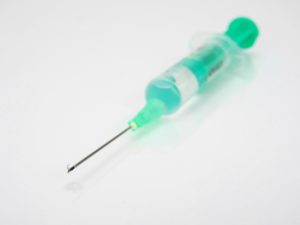Catheter-related bloodstream infection associated with midline catheters

“This study provides the first systematic assessment of the risk of CRBSI between MCs and PICCs and provides evidence for the selection of appropriate vascular access devices for intravenous infusion therapy in nursing” Lu et al (2020).
Injectable medication practices of registered nurses – Full Text

“To identify the self-reported injectable medications of nursing professionals in the state of São Paulo” Roseira et al (2020).
Increased knowledge of intravenous peripheral catheter fracture

“Fracture of a peripheral intravenous cannula in situ is a rare, potentially serious complication that is underreported” Nyamuryekung’e et al (2020).
Central venous catheters as tunnelled mid-clavicular midline catheters

“Conventional Central Venous Catheters can be effectively used as tunnelled Midclavicular midline catheters in low resource settings” Thiyagarajan and Ravindran (2020).
HAI reduction program from the Turkish Ministry of Health

“o address the high prevalence of HAI, Turkish Ministry of Health introduced a national infection control program in 2005” Gozel et al (2020).
Comparing PICC with short peripheral IV catheter for chemotherapy

“Routine PICC insertion in terminally ill cancer patients was comparable in safety and efficacy and resulted in superior satisfaction compared with usual IV access” Park et al (2020).
Compatibility of clonidine with drugs used in intensive care – Full Text

“The intravenous pharmacotherapy of critically ill patients is extremely challenging due to the high number of drugs administered” Koller et al (2020).
Sciatic nerve injury due to intramuscular injection

“This study aimed to determine whether there is a correlation between neuropathic pain and electrodiagnostic findings in SNIII” Fidancı and Öztürk (2020).
Reconstruction of complex central venous occlusion

“A supraclavicular extra-anatomic path can be used safely and effectively to place new UE vascular access or salvage threatened access in this challenging patient population” Uceda et al (2020).
Needlestick and sharp injuries among nurses working in Ethiopia

“The objective of this study was to assess the magnitude and determinants of needlestick and/or sharp injuries among nurses working at Tikur Anbessa Specialized Hospital, Addis Ababa, Ethiopia, 2018” Liyew et al (2020).
The use of antiseptic barrier caps to protect stopcocks from contamination

“To our knowledge, this is the first study to assess Luer hubs on stopcocks without the use of NFCs” Guyot et al (2020).
Intraosseous adenosine administration in a newborn infant – Full Text

“SVT is rare in the neonatal period and SVT is successfully terminated with the administration of intraosseous adenosine” Fidancı et al (2020).
Caprini thrombosis risk model to predict risk of PICC-related UEDVT

“To use the Caprini thrombosis risk model and color Doppler flow imaging (CDFI) for the dynamic monitoring of an eventual thrombosis in patients receiving chemotherapy” Lin et al (2020).
Non-pharmacological methods of venipuncture pain management

“To analyse the literature on non-pharmacological methods of pain management in children undergoing venipuncture” Tibaldo et al (2020).
Results of stenting for central venous occlusions and stenoses

“We aim to investigate the results of stenting for central venous occlusions and stenoses in the hemodialysis patients” Eguchi and Honma (2020).
Vascular access nurses play critical roles in all aspects of PICC-care

“We compared PICC-related processes across hospitals with different insertion delivery models” Krein et al (2020).
Impact of neonatal environment on CLABSI rates – Full Text

“This study aims to examine the effect of single-room units (SRU) versus open-bay units (OBU) on the incidence of NIs, including central-line-associated bloodstream infections (CLABSI), in preterm neonates” Jansen et al (2020).
Intracavitary-ECG for tip location of femorally inserted central catheters

“IC-ECG P-wave characteristics identify optimal tip position at the inferior cavoatrial junction and are different from characteristics at the superior cavoatrial junction” Weber et al (2020).
Ultrasound-guided dynamic needle tip positioning complication

“The removed catheter was noted to be bent at approximately one-third of the catheter length from the tip” Takeshita et al (2020).
Streamlining procedural workflow in COVID-19 patients. – Full Text

“This position article highlights key interventions for COVID-19 treatment and covers several important issues such as endotracheal intubation and tracheostomy (surgical vs PCT), nebulization, bronchoscopy, and invasive procedures such as central venous catheters, arterial lines, and HD catheters” Pande et al (2020).
What is the impact of a vascular access team on IV complication rates?

“Low complication rates and high overall satisfaction scores in patients and professionals were observed, showing that a specialist VAT can have a positive impact in the insertion of PICCs and which also has a clear economic benefit” Corcuera Martínez et al (2020).
Retrieval of peripherally inserted central catheter fragment – Full Text

“The authors propose the simultaneous use of two different approaches for the recovery of a CVC fragment from the pulmonary artery” Papa et al (2020).
PICC tip confirmation in oncology and haematology patients

“To evaluate the efficacy of Peripherally Inserted Central Catheter positioning through an Integrated System (ultrasound-guided and electrocardiogram confirmation).” Fiorini et al (2020).
Management of patients with life-threatening SVC syndrome

“The management of patients with life-threatening SVC syndrome is evolving from radiation therapy to endovascular therapy as the first-line treatment” Azizi et al (2020).
Tunneled central venous access technique in children

“The purpose of this study was to compare open insertion to ultrasound guided percutaneous insertion of central access catheters performed in a tertiary pediatric hospital in terms of its safety and complication rates” Soundappan et al (2020).
Comparison of long peripheral IV catheters in patients with DIVA

“The aim of the study was to compare the frequency of complications of two types of long peripheral catheters with different length inserted in DIVA patients” Pavelkova et al (2020).
Parenteral lidocaine for cancer pain in home or hospice – Full Text

“While advantageous in advanced cancer, evidence is lacking for parenteral Lidocaine use in community-based care” Chong and Yeo (2020).
Intraosseous adrenaline administration in cardiac arrest

“The adrenaline delivery method chiefly involved intraosseous infusion and intravenous access” Zhang et al (2020).
Point-of-care ultrasound for the management of febrile infants

“Point-of-care ultrasound has also been shown to facilitate obtaining IV access in infants as well as confirming the proper placement of intraosseous lines” Delacruz et al (2020).
Optimal intravenous iron dose to treat iron deficiency anaemia

“This reassures that 1 g dose of intravenous iron is sufficient for most patients, with benefits for treatment costs and patient convenience” Karim et al (2020).

